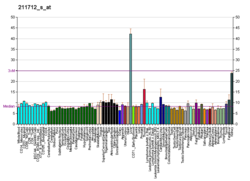Protein-coding gene in the species Homo sapiens
| ANXA9 |
|---|
|
| Identifiers |
|---|
| Aliases | ANXA9, ANX31, annexin A9 |
|---|
| External IDs | OMIM: 603319; MGI: 1923711; HomoloGene: 2643; GeneCards: ANXA9; OMA:ANXA9 - orthologs |
|---|
| Gene location (Human) |
|---|
 | | Chr. | Chromosome 1 (human)[1] |
|---|
| | Band | 1q21.3 | Start | 150,982,249 bp[1] |
|---|
| End | 150,995,634 bp[1] |
|---|
|
| Gene location (Mouse) |
|---|
 | | Chr. | Chromosome 3 (mouse)[2] |
|---|
| | Band | 3|3 F2.1 | Start | 95,203,407 bp[2] |
|---|
| End | 95,214,487 bp[2] |
|---|
|
| RNA expression pattern |
|---|
| Bgee | | Human | Mouse (ortholog) |
|---|
| Top expressed in | - body of pancreas
- right lobe of liver
- skin of leg
- skin of abdomen
- pancreatic ductal cell
- testicle
- amniotic fluid
- C1 segment
- left lobe of thyroid gland
- right lobe of thyroid gland
|
| | Top expressed in | - esophagus
- lip
- seminal vesicula
- skin of back
- skin of external ear
- epidermis
- hair follicle
- renal pelvis
- conjunctival fornix
- vestibular membrane of cochlear duct
|
| | More reference expression data |
|
|---|
| BioGPS | 
 | | More reference expression data |
|
|---|
|
| Gene ontology |
|---|
| Molecular function | - calcium-dependent phospholipid binding
- calcium ion binding
- acetylcholine receptor activity
- phosphatidylserine binding
- protein binding
- phospholipid binding
- protein homodimerization activity
| | Cellular component | | | Biological process | - signal transduction
- cell-cell adhesion
| | Sources:Amigo / QuickGO |
|
| Orthologs |
|---|
| Species | Human | Mouse |
|---|
| Entrez | | |
|---|
| Ensembl | | |
|---|
| UniProt | | |
|---|
| RefSeq (mRNA) | | |
|---|
NM_001085383
NM_023628
NM_001379545
NM_001379546 |
|
|---|
| RefSeq (protein) | | |
|---|
NP_001078852
NP_076117
NP_001366474
NP_001366475 |
|
|---|
| Location (UCSC) | Chr 1: 150.98 – 151 Mb | Chr 3: 95.2 – 95.21 Mb |
|---|
| PubMed search | [3] | [4] |
|---|
|
| Wikidata |
| View/Edit Human | View/Edit Mouse |
|
Annexin A9 is a protein that in humans is encoded by the ANXA9 gene.[5][6][7]
Function
The annexins are a family of calcium-dependent phospholipid-binding proteins. Members of the annexin family contain 4 internal repeat domains, each of which includes a type II calcium-binding site. The calcium-binding sites are required for annexins to aggregate and cooperatively bind anionic phospholipids and extracellular matrix proteins. This gene encodes a divergent member of the annexin protein family in which all four homologous type II calcium-binding sites in the conserved tetrad core contain amino acid substitutions that ablate their function. However, structural analysis suggests that the conserved putative ion channel formed by the tetrad core is intact.[7]
References
- ^ a b c GRCh38: Ensembl release 89: ENSG00000143412 – Ensembl, May 2017
- ^ a b c GRCm38: Ensembl release 89: ENSMUSG00000015702 – Ensembl, May 2017
- ^ "Human PubMed Reference:". National Center for Biotechnology Information, U.S. National Library of Medicine.
- ^ "Mouse PubMed Reference:". National Center for Biotechnology Information, U.S. National Library of Medicine.
- ^ Morgan RO, Fernandez MP (Sep 1998). "Expression profile and structural divergence of novel human annexin 31". FEBS Letters. 434 (3): 300–4. doi:10.1016/S0014-5793(98)00997-1. PMID 9742942. S2CID 13751169.
- ^ Morgan RO, Bell DW, Testa JR, Fernandez MP (Feb 1999). "Human annexin 31 genetic mapping and origin". Gene. 227 (1): 33–8. doi:10.1016/S0378-1119(98)00597-6. PMID 9931420.
- ^ a b "Entrez Gene: ANXA9 annexin A9".
External links
Further reading
- Benz J, Hofmann A (1997). "Annexins: from structure to function". Biological Chemistry. 378 (3–4): 177–83. PMID 9165068.
- Nguyen VT, Ndoye A, Grando SA (Sep 2000). "Pemphigus vulgaris antibody identifies pemphaxin. A novel keratinocyte annexin-like molecule binding acetylcholine". The Journal of Biological Chemistry. 275 (38): 29466–76. doi:10.1074/jbc.M003174200. PMID 10899159.
- Goebeler V, Ruhe D, Gerke V, Rescher U (Jul 2003). "Atypical properties displayed by annexin A9, a novel member of the annexin family of Ca(2+) and lipid binding proteins". FEBS Letters. 546 (2–3): 359–64. doi:10.1016/S0014-5793(03)00634-3. PMID 12832069. S2CID 13433731.
- Beausoleil SA, Jedrychowski M, Schwartz D, Elias JE, Villén J, Li J, Cohn MA, Cantley LC, Gygi SP (Aug 2004). "Large-scale characterization of HeLa cell nuclear phosphoproteins". Proceedings of the National Academy of Sciences of the United States of America. 101 (33): 12130–5. Bibcode:2004PNAS..10112130B. doi:10.1073/pnas.0404720101. PMC 514446. PMID 15302935.



















